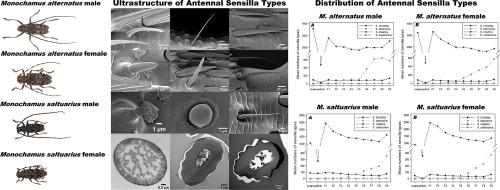Journal of Asia-Pacific Entomology ( IF 1.1 ) Pub Date : 2022-12-05 , DOI: 10.1016/j.aspen.2022.102024 Min-Jung Huh , Ji-Hong Park , Gwang-Hyun Roh , Il-Kwon Park

|
As insect vectors of pine wood nematodes, Monochamus alternatus Hope and Monochamus saltuarius Gebler have different levels of attractiveness to semiochemicals. Although active use of chemical communication in both species is well known, there was no report on the differences in morphology and distribution of antennal sensilla between the two Monochamus species. The present study was carried out to explore the morphology, distribution, and ultrastructure of antennal sensilla of the two species using scanning and transmission electron microscopy. The overall shapes of the antennae were not different between M. alternatus and M. saltuarius. However, both M. alternatus and M. saltuarius exhibited sexual dimorphism overall. The antennae of each species were composed of the scape, pedicel, and nine flagellomeres, with four morphological types of sensilla: trichodea, basiconica, chaetica, and coeloconica. The four types occurred in varying numbers and distributions. The sensilla chaetica type was the most abundant in both species. Three types of sensilla (trichodea, basiconica, and chaetica) could be subdivided according to the two Monochamus species; sensilla trichodea could be divided into two subtypes, and sensilla basiconica and sensilla chaetica into three. All sensilla basiconica subtypes were multiporous, indicating that their primary function was olfactory. Sensilla trichodea subtype 2 was uniporous, indicating that the function of these sensilla might be gustatory. The morphological information obtained in our study provides a basis for future investigation of the sensory physiological function of each type of sensilla in the two species.
中文翻译:

松木线虫昆虫载体 Monochamus alternatus Hope 和 Monochamus saltuarius Gebler 触角感受器的形态和分布(鞘翅目:天牛科)
作为松材线虫的昆虫载体,Monochamus alternatus Hope和Monochamus saltuarius Gebler对化学信息素具有不同程度的吸引力。虽然这两个物种都积极使用化学通讯是众所周知的,但没有关于这两个Monochamus物种之间触角感器的形态和分布差异的报道。本研究旨在利用扫描和透射电子显微镜探索这两个物种的触角感受器的形态、分布和超微结构。M. alternatus和M. saltuarius的触角整体形状没有差异。然而,M. alternatus和M. saltuarius总体上表现出性二态性。每个物种的触角由花茎、花梗和九个鞭毛组成,具有四种形态类型的感器:trichodea、basiconica、chaetica 和 coeloconica。这四种类型的发生数量和分布各不相同。感觉器 chaetica 类型在这两个物种中是最丰富的。三种类型的感器(trichoda、basonica 和 chaetica)可以根据两个Monochamus细分物种; sensilla trichodea 可分为两个亚型,sensilla basonica 和 sensilla chaetica 分为三个亚型。所有基本感器亚型都是多孔的,表明它们的主要功能是嗅觉。感觉器 trichodea 亚型 2 是单孔的,表明这些感觉器的功能可能是味觉的。在我们的研究中获得的形态学信息为未来研究这两个物种中每种类型的感受器的感觉生理功能提供了基础。













































 京公网安备 11010802027423号
京公网安备 11010802027423号